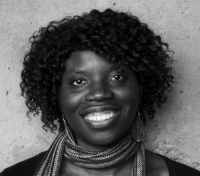
A designer, urbanist, and social innovator, Liz Ogbu focuses on sustainable design and spatial innovation in challenged urban environments around the world. Currently, she has her own multidisciplinary consulting practice that works with nonprofits, municipalities, and companies to tackle wicked social problems through creative transformations of places, systems, and communities. Her clients include the Nike Foundation and PG&E. In 2011, Ogbu was part of the inaugural class of Innovators-in-Residence at IDEO.org, IDEO’s sister nonprofit dedicated to fostering global poverty reduction through design and innovation. Prior to that, she was Design Director at Public Architecture, a national nonprofit mobilizing designers to create social change.
In addition to her practice work, Ogbu has had a long commitment to bringing social impact work into the classroom where her courses and research explore opportunities at intersection of design, innovation, and community engagement. She has taught at the California College of the Arts, the d.school at Stanford, and is a lecturer in the College of Environmental Design at UC Berkeley. Ogbu has written for and been profiled in publications such as Places Journal, Metropolis, Core 77 and the Journal of Urban Design. Her work has been exhibited at the Cooper-Hewitt National Design Museum, Rotterdam Biennale and Yerba Buena Center for the Arts.
Recently, Ogbu led a product design workshop at the Blum Center, funded in part by a grant from the Autodesk Foundation. She took some time to talk with us about how she became interested in design and social impact.
Q: When you started your training as an architect did you always think you’d gravitate to the impact design field or did you consider more mainstream architecture?
I’ve always looked at the social being inextricably linked with design. That’s why I’ve crafted my education and my career with that frame in mind. It’s interesting to note that in the early stages of my career, this kind of thinking was often considered separate from mainstream architecture. Now, more mainstream architects are increasingly looking in that direction. In other words, my way of engaging design is becoming more the norm.
Q: What influenced you to pursue a career in impact design? How do you think your work at IDEO.org has catalyzed your career?
Being raised by social scientists and having the freedom to design an architecture education that links design and social issues, helped to build the foundation for my career in impact design. My time at IDEO.org played an important role in my career. By the time I did the IDEO.org fellowship, I was already well ensconced in the field through the many years that I had spent at Public Architecture. IDEO.org enabled me to engage a broader understanding of design to look beyond architecture to the languages of product design, business design, etc. It was also helpful for teaching me the Human-Centered Design process.
Q: Top-down development approaches often face criticism for being non-participatory and even neocolonial. Much of your work is informed by ethnographies and interviews with the stakeholders you are trying to serve. Do you envision these methods spreading in the development sector? If so, why?
Yes, I think that more people are embracing the idea of focusing on the people at the heart of these problems. While there have been a variety of solutions applied to the most intractable problems over the last several decades that have generated some improvements, there have been many challenges that haven’t seen much movement. Clients (foundations, nonprofits, governments, and companies) and practitioners have been looking for deeper, more provocative solutions that can navigate these challenges. As a result, many have come to realize that the heart of many of these problems are the very people affected. Until we crack the nut of what is behind the needs, aspirations, and behaviors connected with the issues, we will never effectively solve them. For many of my clients, Human-Centered Design is a mechanism to move in this direction.
Q: The gender and race gap in the technology industry is well documented. Recent trends in the field of Development Engineering have tried to counter this. As a woman, person of color, and industry insider, what are your views on both of these trends?
It’s great that a light is being shined on these kinds of challenges. But the critiques haven’t gone deep enough. These are systemic issues and if we want to make changes at the systems level then we need to make systemic interventions. Adding diversity programs is not enough. There needs to be a critical awareness of why these issues exist and corresponding investments to address them. Ironically, some of the reasons why these issues exist are deeply personal. Racism, sexism, and bias have systemic impacts but are rooted in individual emotions. Figuring out how to have more authentic, vulnerable conversations is also critical to moving the needle.
Q: What advice would you give to students looking to follow in your footsteps?
The great – and sometimes maddening – aspect of this kind of work is that there is no direct path. My colleagues and I represent a variety of trajectories and skills. I think it’s important to figure out what you’re really good at and passionate about. Use that to help you understand where to dive deep. I also think it’s important to be entrepreneurial, whether at school or in the workforce. Take advantage of opportunities to expand your thinking, your network, and your training.
That being said, there are some academic programs focused on training people specifically around this kind of work, such as the Design Matters concentration at ArtCenter College of Design and the Master of Social Design at MICA (Maryland Institute College of Art). There are also some summer programs such as the Design Futures Symposium and post professional opportunities, such as the Rose Fellowship.